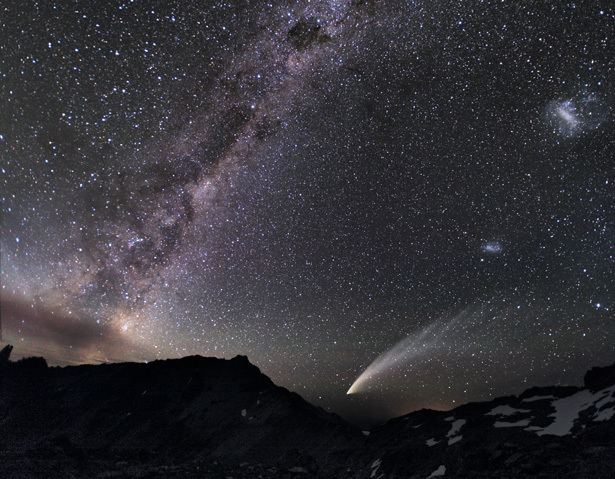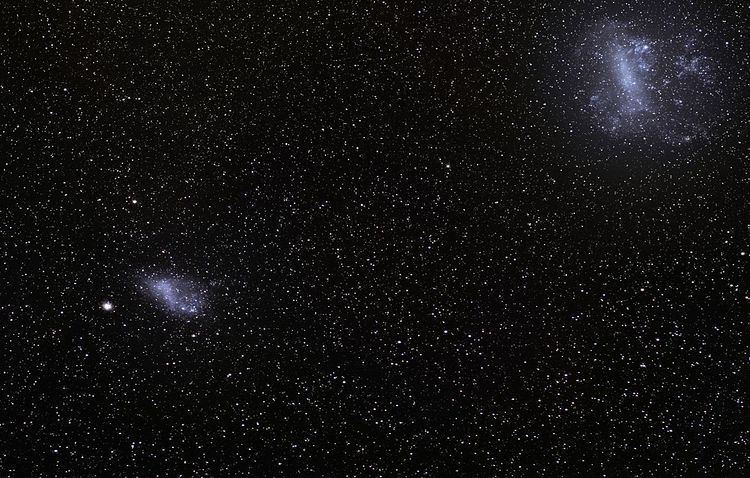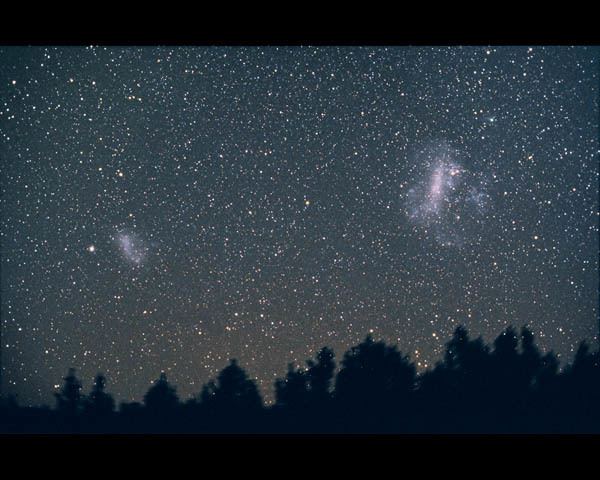 | ||
A tour of the large and small magellanic clouds nasa space science hd video
The Magellanic Clouds (or Nubeculae Magellani) are two irregular dwarf galaxies visible from the southern hemisphere; they are members of the Local Group and are orbiting the Milky Way galaxy. Because they both show signs of a bar structure, they are often reclassified as Magellanic spiral galaxies. The two galaxies are:
Contents
- A tour of the large and small magellanic clouds nasa space science hd video
- Bouncy ball magellanic clouds 1 21
- History
- Characteristics
- Mini Magellanic Cloud MMC
- References

Bouncy ball magellanic clouds 1 21
History

The Magellanic Clouds were known to the Polynesians and served as important navigation markers. Collectively they were known to Māori of New Zealand as Nga Patari-Kaihau or as Te Reporepo and were also used as predictors of winds.

The Magellanic Clouds have been known since the first millennium in Western Asia. The first preserved mention of the Large Magellanic Cloud is by the Persian astronomer Al Sufi. In 964, in his Book of Fixed Stars, under Argo Navis, he quoted that "unnamed others have claimed that beneath Canopus there are two stars known as the 'feet of Canopus' , and beneath those there are bright white stars that are unseen in Iraq nor Najd, and that the inhabitants of Tihama call them al-Baqar [cows], and Ptolemy did not mention any of this so we [Al-Sufi] does not know if this is true or false."
In Europe, the Clouds were first observed by Italian explorers Peter Martyr d'Anghiera and Andrea Corsali at the end of the 15th century. Subsequently, they were reported by Antonio Pigafetta, who accompanied the expedition of Ferdinand Magellan on its circumnavigation of the world in 1519–1522. However, naming the clouds after Magellan did not become widespread until much later. In Bayer's Uranometria they are designated as nubecula major and nubecula minor. In the 1756 star map of the French astronomer Lacaille, they are designated as le Grand Nuage and le Petit Nuage ("the Large Cloud" and "the Small Cloud").

In Sri Lanka, from ancient times, these clouds have been referred to as the Maha Mera Paruwathaya meaning "the great mountain", as they look like the peaks of a distant mountain range.
Characteristics

The Large Magellanic Cloud and its neighbour and relative, the Small Magellanic Cloud, are conspicuous objects in the southern hemisphere, looking like separated pieces of the Milky Way to the naked eye. Roughly 21° apart in the night sky, the true distance between them is roughly 75,000 light-years. Until the discovery of the Sagittarius Dwarf Elliptical Galaxy in 1994, they were the closest known galaxies to our own (since 2003, the Canis Major Dwarf Galaxy was discovered to be closer still, and is now considered the actual nearest neighbor). The LMC lies about 160,000 light years away, while the SMC is around 200,000. The LMC is about twice the diameter of the SMC (14,000 ly and 7,000 ly respectively). For comparison, the Milky Way is about 100,000 ly across.
Astronomers have long believed that the Magellanic Clouds have orbited the Milky Way at approximately their current distances, but evidence suggests that it is rare for them to come as close to the Milky Way as they are now. Observation and theoretical evidence suggest that the Magellanic Clouds have both been greatly distorted by tidal interaction with the Milky Way as they travel close to it. Streams of neutral hydrogen connect them to the Milky Way and to each other, and both resemble disrupted barred spiral galaxies. Their gravity has affected the Milky Way as well, distorting the outer parts of the galactic disk.
Aside from their different structure and lower mass, they differ from our galaxy in two major ways. First, they are gas-rich; a higher fraction of their mass is hydrogen and helium compared to the Milky Way. They are also more metal-poor than the Milky Way; the youngest stars in the LMC and SMC have a metallicity of 0.5 and 0.25 times solar, respectively. Both are noted for their nebulae and young stellar populations, but as in our own galaxy their stars range from the very young to the very old, indicating a long stellar formation history.
The Large Magellanic Cloud was host galaxy to a supernova (SN 1987A), the brightest observed in over four centuries.
Measurements with the Hubble Space Telescope, announced in 2006, suggest the Magellanic Clouds may be moving too fast to be long term companions of the Milky Way.
Mini Magellanic Cloud (MMC)
Astrophysicists D. S. Mathewson, V. L. Ford and N. Visvanathan proposed that the SMC may in fact be split in two, with a smaller section of this galaxy behind the main part of the SMC (as seen from Earth's perspective), and separated by about 30,000 light years. They suggest the reason for this is due to a past interaction with the LMC splitting the SMC, and that the two sections are still moving apart. They have dubbed this smaller remnant the Mini Magellanic Cloud.
